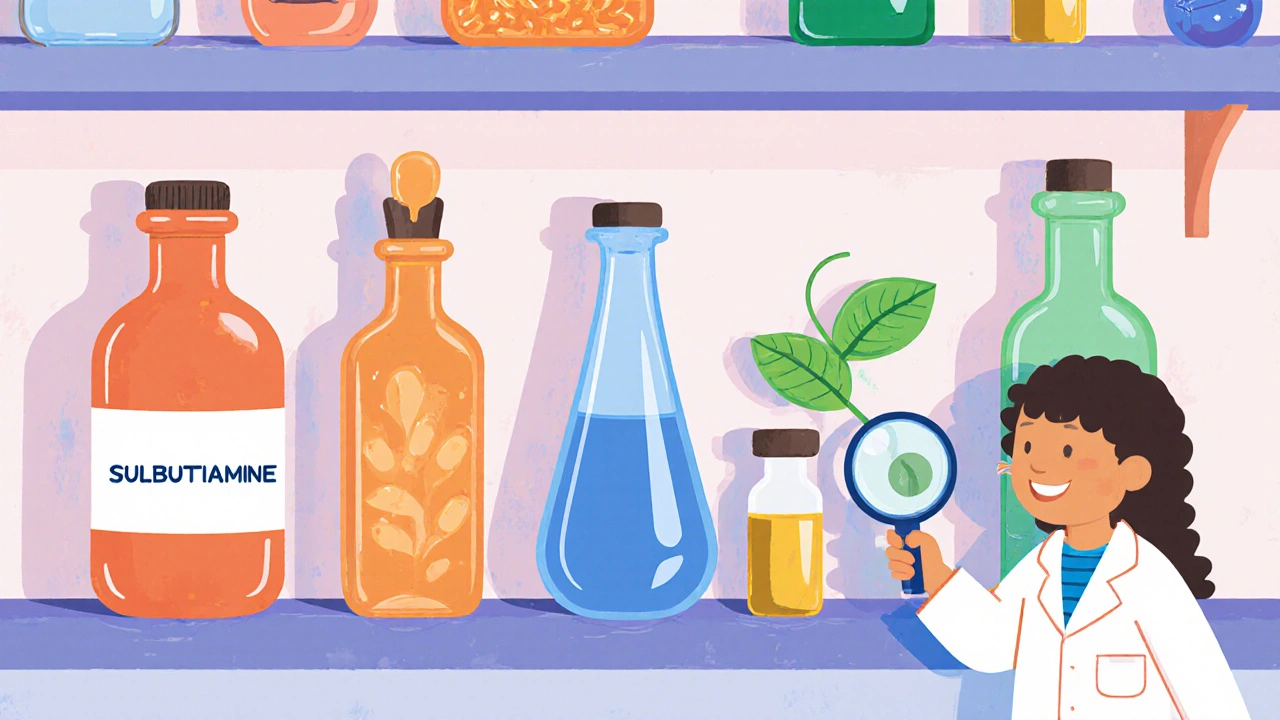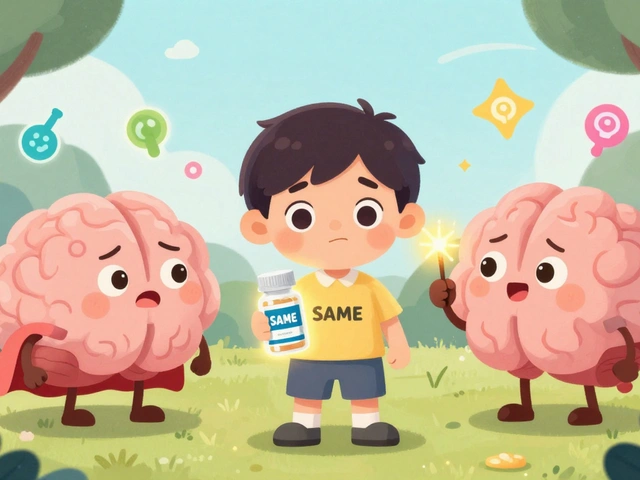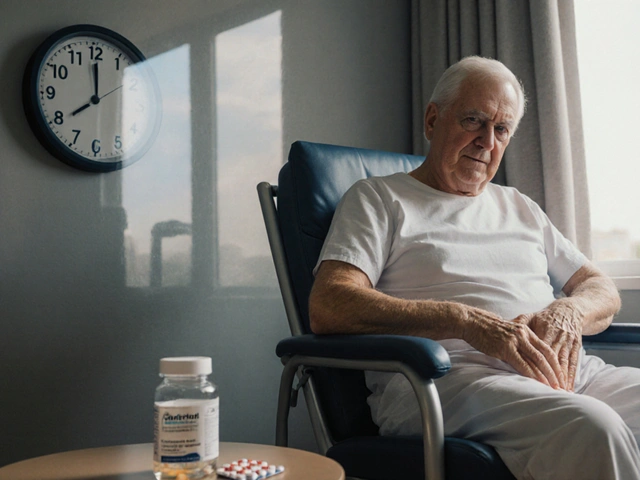Nootropic Selection Guide
Find Your Perfect Nootropic Match
Answer a few simple questions about your cognitive goals and tolerance to find nootropics that align with your needs.
Your Primary Goal
Your Tolerance Preferences
Looking for a lift in focus, memory, or mood? Arcalion often pops up in supplement aisles, but it’s not the only game in town. This guide breaks down what makes Arcalion (a brand of sulbutiamine) different from other popular nootropics, so you can decide which one actually fits your brain‑boosting goals.
Key Takeaways
- Arcalion is a synthetic derivative of vitamin B1 that crosses the blood‑brain barrier more efficiently than thiamine.
- Benfotiamine offers a similar fat‑soluble B1 profile but focuses more on metabolic health than cognition.
- Alpha GPC and Cereboost deliver choline or luteolin, targeting acetylcholine pathways for memory.
- Piracetam and Noopept are classic racetams that enhance synaptic plasticity but may cause headaches without choline.
- Safety, dosing, and personal goals are the biggest factors when choosing a nootropic.
What Is Arcalion (Sulbutiamine)?
Arcalion is the trade name for sulbutiamine, a synthetic thiamine (vitamin B1) derivative developed in Japan in the 1960s. Sulbutiamine consists of two thiamine molecules linked together, making it lipophilic enough to cross the blood‑brain barrier more readily than regular thiamine. Once inside the brain, it is broken down into two thiamine units, boosting the levels of thiamine‑dependent enzymes involved in energy metabolism.
People take Arcalion mainly for three reasons: improving mental fatigue, enhancing mood, and supporting physical stamina. Clinical trials in the 1990s reported modest improvements in reaction time and self‑rated fatigue, especially in individuals with chronic fatigue syndrome.
How Sulbutiamine Works - The Science in Plain English
Thiamine is a co‑factor for enzymes like pyruvate dehydrogenase, which turns glucose into ATP - the cell’s energy currency. By delivering more thiamine to neurons, sulbutiamine can increase ATP production, helping brain cells fire more efficiently.
Beyond energy, sulbutiamine appears to modulate dopamine pathways. Animal studies show it can raise dopamine turnover in the prefrontal cortex, which may explain the reported mood‑lifting effects.
Because it’s fat‑soluble, sulbutiamine is taken in lower milligram doses (usually 200‑400 mg per day) compared with thiamine’s 100 mg+ requirements for a similar brain effect.
Popular Alternatives to Arcalion
When you browse nootropic forums, a handful of compounds keep showing up as alternatives. Below is a quick snapshot of each, focusing on their primary mechanism, typical dosage, and what they’re best known for.
- Benfotiamine - a fat‑soluble form of thiamine that targets blood‑sugar‑related nerve damage rather than pure cognition.
- Alpha GPC - a choline source that boosts acetylcholine, the neurotransmitter tied to memory formation.
- Cereboost - a blend of coffee fruit extract, luteolin, and vitamin C designed to increase blood flow and protect neurons.
- Piracetam - the original racetam, enhancing synaptic plasticity via AMPA‑receptor modulation.
- Noopept - a peptide‑like racetam touted for faster learning and neuroprotection.
- Bacopa monnieri - an herb that supports memory through antioxidant and adaptogenic pathways.

Side‑by‑Side Comparison Table
| Supplement | Primary Mechanism | Typical Dose | Core Benefits | Common Side Effects |
|---|---|---|---|---|
| Arcalion (Sulbutiamine) | Fat‑soluble B1 precursor → ↑ neuronal ATP & dopamine | 200‑400 mg/day | Reduced mental fatigue, mood lift, mild stamina boost | Headache, insomnia (high dose) |
| Benfotiamine | Fat‑soluble B1 → supports glucose metabolism | 150‑300 mg/day | Neuropathy relief, metabolic support | Rare GI upset |
| Alpha GPC | Choline donor → ↑ acetylcholine synthesis | 300‑600 mg 2‑3×/day | Memory, focus, quick mental recall | Headache, dizziness |
| Cereboost | Luteolin & caffeine metabolites → ↑ cerebral blood flow | 500‑1000 mg/day | Alertness, neuro‑protection | Jitteriness (caffeine‑sensitive users) |
| Piracetam | Racetam → modulates AMPA receptors & cerebral blood flow | 1.2‑4.8 g/day | Learning, sensory perception | Headache (often mitigated with choline) |
| Noopept | Peptide‑like racetam → BDNF & NGF up‑regulation | 10‑30 mg/day | Fast learning, neuro‑protective | Irritability, insomnia |
| Bacopa monnieri | Adaptogenic herb → antioxidant & GABA modulation | 300‑600 mg of extract (50 % bacosides) | Memory consolidation, stress reduction | GI upset, dry mouth |
Pros and Cons - When Arcalion Shines and When It Falls Short
Pros of Arcalion
- Excellent brain penetration compared with regular thiamine.
- Low dosage needed, making it easy to stack with other supplements.
- Well‑tolerated in most healthy adults.
- Beneficial for both mental fatigue and mild mood dips.
Cons of Arcalion
- Effects plateau after a few weeks; cycling may be required.
- Not a strong memory enhancer on its own.
- Potential headache if taken late in the day.
- Limited peer‑reviewed data beyond the 1990s.
Alternatives like Alpha GPC or Bacopa tend to excel in memory tasks, while racetams (Piracetam, Noopept) are stronger for learning speed but need choline to avoid headaches. If your main goal is fighting fatigue, Arcalion stays a solid first‑line choice.
Choosing the Right Nootropic for Your Needs
Start by ranking what matters most to you:
- Goal: fatigue vs memory vs focus vs neuro‑protection.
- Tolerance: sensitivity to caffeine, choline, or racetam headaches.
- Budget: some racetams require multiple daily doses, raising cost.
- Safety profile: any pre‑existing conditions or medications?
If fatigue tops the list, try Arcalion at 200 mg in the morning. Add a low‑dose choline (Alpha GPC 300 mg) if you notice a mild headache. For memory‑heavy tasks, swap in Bacopa monnieri (standardized to 50 % bacosides) and keep the dosage consistent for 8‑12 weeks - that’s the period where herbal adaptogens tend to show results.
Safety, Regulations, and Stackability
Arcalion is sold as a dietary supplement in many countries, but it’s not FDA‑approved as a medication. In the EU, it’s classified under “food supplements” and must meet the Novel Food regulation if the product exceeds 2 % of the daily intake.
When stacking, keep a few rules in mind:
- Never exceed 400 mg of sulbutiamine per day without medical supervision.
- Combine with a choline source if you plan to add a racetam; this will curb headaches.
- Watch for overlapping B‑vitamin content - high doses of thiamine can cause rare allergic reactions.
Always check with a healthcare professional if you’re pregnant, nursing, or on prescription meds, especially anticoagulants or diabetes drugs.
Bottom Line - Does Arcalion Beat the Competition?
If you need a simple, low‑dose boost for mental fatigue and a modest mood lift, Arcalion still holds its own. It isn’t the most potent memory enhancer, but its safety record and ease of use make it a reliable starter nootropic.
For users after sharper recall, faster learning, or stronger neuro‑protective effects, pairing or swapping with Alpha GPC, Bacopa, or a racetam stack will likely yield better results.
Ultimately, the "best" choice hinges on personal goals, tolerance, and how much you enjoy tinkering with stacks. Start small, track your response, and adjust accordingly.
Frequently Asked Questions
Can I take Arcalion with caffeine?
Yes, most people combine Arcalion with a cup of coffee or tea without issues. If you’re sensitive to stimulants, start with a lower caffeine dose to see how your heart rate reacts.
How long does it take to feel the effects of sulbutiamine?
Most users report a noticeable reduction in mental fatigue within 3‑5 days of consistent dosing. Full mood‑lifting benefits may take up to two weeks.
Is sulbutiamine safe for long‑term use?
Clinical data support up to 12 weeks of daily use at recommended doses. For longer periods, a 2‑week break is advised to avoid potential tolerance.
Can I stack Arcalion with other nootropics?
Yes. It stacks well with choline donors (Alpha GPC, CDP‑choline) and mild adaptogens like Rhodiola. Avoid stacking two high‑dose racetams together to reduce headache risk.
What’s the difference between sulbutiamine and benfotiamine?
Both are fat‑soluble B1 forms, but sulbutiamine is designed for brain energy and dopamine modulation, while benfotiamine targets peripheral nerve health and glucose metabolism.





9 Comments
Tracy O'Keeffe
Oh great, another silicon‑shiny promise that sulbutiamine will turn your brain into a hyper‑focused supercomputer. The hype train rolls in, but the actual data is more of a pothole‑strewn backroad. Sure, 200 mg can nudge ATP production, yet for real cognitive alchemy you still need choline, BDNF boosters and a dash of disciplined sleep.
Let's not pretend this is the holy grail of nootropics when the evidence pool is still a puddle of small‑scale trials. In short, treat it like a modst mood‑lift, not a miracle‑pill.
Rajesh Singh
When you start dabbling with any supplement that meddles with neurotransmitters, the moral compass should point toward caution. Stacking sulbutiamine with caffeine might feel like a brisk jog, but it can also nudge the heart into an uneasy sprint, especially for those with hidden cardiac quirks. The community often glorifies short‑term buzz while ignoring the subtle erosion of natural homeostasis.🧠💭 Respect the body’s innate balance, and never chase a fleeting high at the expense of long‑term wellness.
Barbara Grzegorzewska
Let’s cut through the noise: sulbutiamine is neither a panacea nor a novelty; it’s a B1 prodrug engineered for lipophilicity. Its pharmacokinetics are well‑documented: rapid absorption, brain‑penetrating, then hydrolysis to thiamine-nothing more exotic than basic esterification. If you’re hunting a serious mnemonic upgrade, why not direct your resources toward cholinergic precursors or even adaptive botanicals with proven long‑term trials? The literature is sparse beyond the 90s, so betting your cognitive future on that thin slice of data is, frankly, intellectually lazy.
Nis Hansen
Rajesh raises a vital point about systemic equilibrium-indeed, the brain cannot be isolated from the body’s rhythmic heart. From a philosophical lens, any cognitive enhancer is a tool, not a crutch; it ought to amplify intrinsic virtues like curiosity and discipline rather than replace them. Therefore, integrating sulbutiamine should be paired with structured sleep hygiene and mindful meditation, ensuring that the boost aligns with holistic growth.
Fabian Märkl
Hey folks, I’ve been mixing 200 mg of Arcalion with a modest 300 mg of Alpha GPC and the combo feels like a smooth caffeine‑free lift 🚀. No headaches, just a subtle clarity that lasts through the afternoon work sprint. If you’re wary of the racetam‑induced buzz, this stack is a gentle entry point. Give it a try and let me know how your focus trades evolve! 🌟
Avril Harrison
Just scrolling through the thread and thinking that the real win is finding something that fits your lifestyle, not just the hype. Whether it’s sulbutiamine, bacopa, or a good ol’ cup of tea, consistency beats occasional spikes every time.
Natala Storczyk
Fabian!!! Your glowing endorsement sounds like a marketing flyer on steroids!!! 🚨💥 But remember, every so‑called “smooth lift” can hide a ticking time‑bomb of tolerance and dependency-if you let it. 🚨⚡️ Stay vigilant, or you’ll be the punch‑line of another reddit cautionary tale!!!
nitish sharma
Dear community, I appreciate the diverse perspectives shared thus far. It is prudent to underline that any supplementation, including sulbutiamine, should be initiated under professional guidance, particularly for individuals with comorbid conditions. Moreover, systematic monitoring of cognitive and physiological responses will facilitate an evidence‑based assessment of efficacy. Let us continue to foster an environment of informed experimentation.
Brian Van Horne
The takeaway: sulbutiamine offers modest energy benefits, but for robust memory you’ll likely need a choline source or adaptogenic herb.